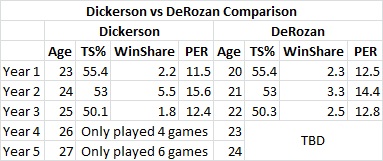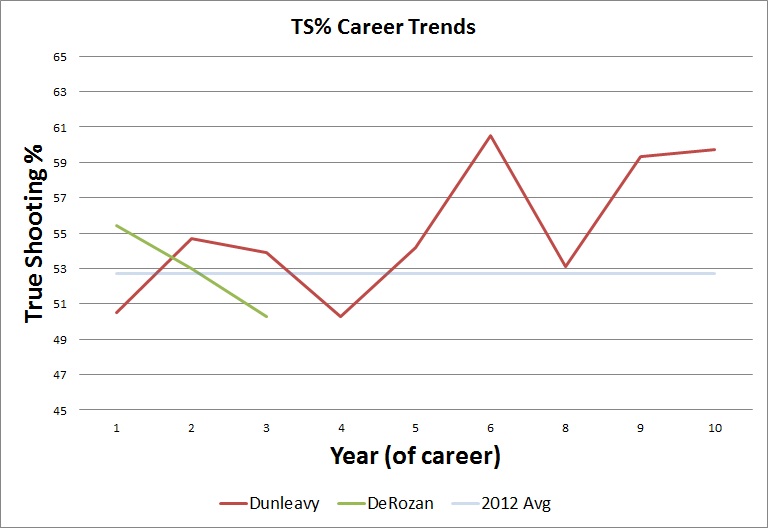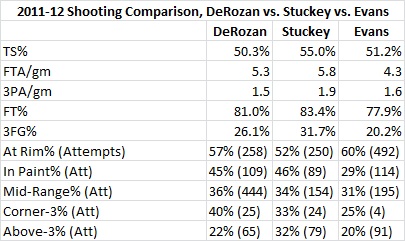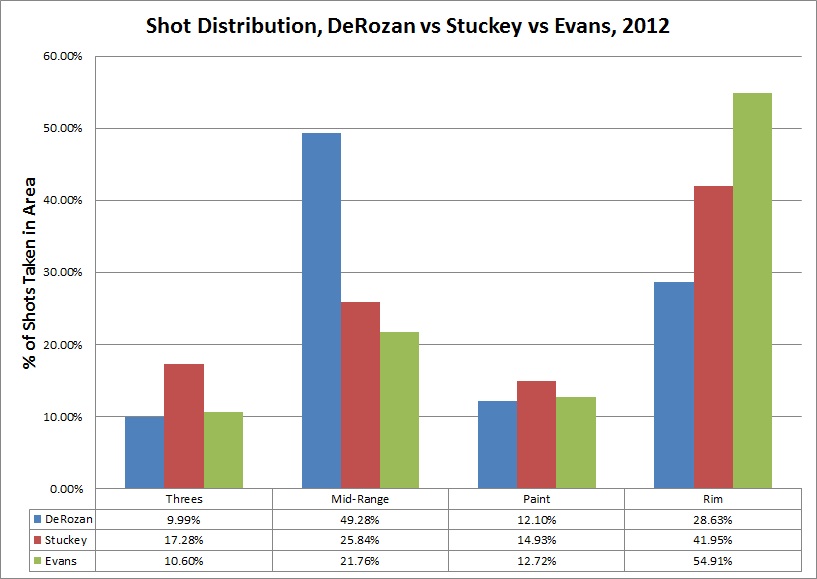With a lot of the pre-season discussion in Raptor land focusing on DeMar DeRozan and how he may evolve in his fourth season, I was curious to see if I could find players with similar career paths. Basketball Reference’s similarity scores don’t really help us in this regard. While fun and interesting at the end of a player’s career, they don’t tell you much about how similar players progress. To wit, DeRozan’s highest similarity score is Raymond Felton, a point guard who has a dissimilar on-court game.
This isn’t a flaw with their scores, because this isn’t what they aim to measure – their similarity scores measure Win Shares ranked from a player’s best to worst season, regardless of style of play. Specifically, I was interested to see if DeRozan’s downward-trending true shooting percentage (TS%) could be looked at as a red herring or if it’s a big red flag about his potential development.
True Shooting Percentage
DeRozan’s TS% in his first three seasons has declined from 55.4% to 53.0% to 50.3%, thanks largely to his increased frequency of three-point shots and his declining two-point field goal accuracy. His free throws have trended upward, preventing an even greater decline. TS% is a shooting percentage that takes three-point shooting and free throws into account. Basically, since regular field goal percentage (FG%) measures two different types of shots in the same way and ignores another, TS% is a more representative measure of the value of one’s shooting efficiency. Thus, while DeMar is a poor three-point shooter, his ability to get to the free throw line (approximately five times per game, just outside the top-10 in the NBA last year) brings his TS% back up.
Method I
To try and find players with a similar career trend in TS%, I ran a Basketball Reference Play Index query for players in the three-point era in their first five years, who were marked as guard, guard-forward, or forward-guard, and qualified for the FG% title (300 field goals made, which DeRozan technically narrowly missed, but bear with me). When I limited the range to single seasons where a player meeting these criteria had a TS% between 49.5% and 60%, I got 800 results.
Results I
The first thing I did was try to see if any player had three individual seasons in these ranges, regardless of the order. It turns out there were only three such players – Kirk Hinrich, Randy Wittman, and Michael Dickerson. Dickerson was the only one who had the same declining pattern as DeRozan, dropping each season from age 23 to 25 (DeRozan dropped from age 20 to 22).  Dickerson isn’t a great comparison for us, because after his first three years he was hampered by hamstring and groin issues, rarely got on the floor, and retired prematurely. Hinrich is a point guard with a dissimilar game (far fewer free throws, strong three-point shooting) and has wildly fluctuated in terms of TS% over his career, while Wittman didn’t get to the line or shoot threes (though for the record, after seeing another TS% decline in his sixth season, he went from being a regular to a sparsely used bench player for the rest of his career).
Dickerson isn’t a great comparison for us, because after his first three years he was hampered by hamstring and groin issues, rarely got on the floor, and retired prematurely. Hinrich is a point guard with a dissimilar game (far fewer free throws, strong three-point shooting) and has wildly fluctuated in terms of TS% over his career, while Wittman didn’t get to the line or shoot threes (though for the record, after seeing another TS% decline in his sixth season, he went from being a regular to a sparsely used bench player for the rest of his career).
Method II
Since we didn’t really get great comps using this methodology, I thought I’d try to alter it. This time, I set a minimum free throw attempts per game of 2 and a maximum three-point attempts per game of 4 and changed the qualification from FG% leader to minutes per game leader, to allow for some more rookies (like DeMar, who played 70 games and thus qualified) in the sample. This time we had a new sample of 717 players.
Results II
Here, I looked for players who had seasons with a TS% of 54.4-56.4, 52.0-54.0 and 49.5-51.3, all within their first five seasons, regardless of the order they occurred in. This gave me 16 results, so we have a little more to work with this time around, although once again DeMar is by far the youngest player in the “high TS%” group (Alvin Robertson and Mike Dunleavy are next closest at 23 to DeMar’s 20). Here we see that Mike Dunleavy is the only other qualified player in the three-point era to experience declining TS% rates in a relatively close range to DeRozan within his first five seasons. So what does this mean for DeMar? 
 While this looks somewhat favourable given that Dunleavy has had some pretty successful seasons, it’s still not a great comparison considering that Dunleavy, while at his peak he got to the line a decent amount, is a relatively dissimilar player to DeRozan, trading free throws for threes.
While this looks somewhat favourable given that Dunleavy has had some pretty successful seasons, it’s still not a great comparison considering that Dunleavy, while at his peak he got to the line a decent amount, is a relatively dissimilar player to DeRozan, trading free throws for threes.
Reflection
So, did I do all of this analysis basically to say that DeRozan doesn’t have any good player comparables? Maybe, and that might sound like a waste of time, but I don’t think so. The fact that there are almost no other instances of a player with a roughly similar profile to DeRozan starting their career off with this kind of a TS% trend is a worthwhile finding on its own. On one hand, you can look at this and claim that he’s doomed, since no other player has experienced such a stark decline to start their career. But you could also say that, since there is no precedent, you could just as easily expect him to rebound or improve as flame out entirely. If we make some pretty reasonable, if optimistic, assumptions, we see how DeRozan’s TS% can improve rather quickly.
TS% Experiment
If we hold DeRozan’s 3PA/game at 1.5 and increase his effectiveness from 26.1% to 28.5%, increase his FTA/game from 5.3 to 5.7 and hold his FT% at 81%, and decrease his total FGA/game from 14.3 to 14, increasing his 2FG% from 44% to 45%, his TS% would improve from 50.3% to 51.8%. These aren’t extreme increases by any means, more or less rounding errors (his points per game would only increase from 16.7 to 17.1). Of course, a 51.8% TS% still isn’t strong (it’s about what Vince Carter did last year), but my point is that he only has to make pretty small improvements to buck his current trend.
Shot Distribution
Just to be thorough and see if I was missing anything, I also took my data set and filtered it for seasons where players had between 4 and 7 FTA/game and between 1 and 2 3PA/game within their first five seasons, and it gave me 46 such seasons. This doesn’t really mean anything either, just that DeRozan’s free-throw and three-point frequencies are relatively uncommon. The average TS% for the sample was 54%, and surprisingly the sample had a three-point percentage average of just 28.1%. Free-throw shooting was also at 78.5%, so basically given his profile, 2FG% is the only thing holding DeMar back from having an adequate TS% given his profile. Looking at his Advanced Stats from NBA.com, we see that DeMar shot 57% at the rim, 45% in the lane, 36% from mid-range, 40% from the corner-three, and 22% from above the three-point line. For comparison, have a look at Rodney Stuckey and Tyreke Evans, who were also a part of this last sample group I created.  Compared to these two players who show similar profiles in terms of threes and free throws, DeRozan shoots a disproportionate amount of mid-range shots. So the onus is on DeRozan to continue to improve his ability to get to the line by attacking more and more, trading mid-range shots for attempts closer to the basket.
Compared to these two players who show similar profiles in terms of threes and free throws, DeRozan shoots a disproportionate amount of mid-range shots. So the onus is on DeRozan to continue to improve his ability to get to the line by attacking more and more, trading mid-range shots for attempts closer to the basket.  Whether or not he’ll be afforded this opportunity sharing the court with Kyle Lowry and Andrea Bargnani is yet to be seen, but the simplest way for DeRozan to make sure he continues to get touches is to make the most of them. And the best way to do that is to get to the rim, where shots fall with a greater frequency and free throws are more likely to follow, both of which should keep DeRozan from becoming a TS% cautionary tale.
Whether or not he’ll be afforded this opportunity sharing the court with Kyle Lowry and Andrea Bargnani is yet to be seen, but the simplest way for DeRozan to make sure he continues to get touches is to make the most of them. And the best way to do that is to get to the rim, where shots fall with a greater frequency and free throws are more likely to follow, both of which should keep DeRozan from becoming a TS% cautionary tale.




